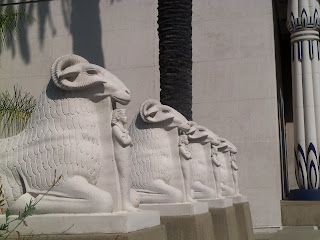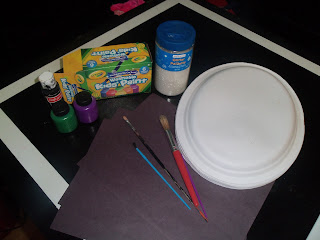A Field Trip to the Egyptian Museum
It's field trip day, YEAH!!! There haven't been too many field trip these last few weeks, so we were due for a fun one. I wasn't sure this was going to be classified by my kids as a "fun one" but they really enjoyed it. We went to the Rosicrucian Egyptian Museum in San Jose, CA. I had never heard of this place before and wasn't sure if it would be kid-friendly, but I figured the few adults that were there on a Wednesday afternoon at 1pm would just have to deal with it. Didn't matter anyway because the kids REALLY enjoyed it and were very well behaved. Plus, the 2 middle school field trips that were also there totally drowned us out :) We saw real mummies of people and animals - did you know they mummified animals too? There was a replica of an underground tomb that you walked through (spooky and fun) and lots and lots of ancient artifacts. There were models of tombs and temples and examples of items used by everyday people. The kids got a "Passport to Ancient Egypt" that they stamped in every exhibit and they seemed genuinely interested in the displays. Did we read every description and see every display case? No, but I usually gloss over a lot of the small details anyway. Did we have a great experience and learn a lot about Ancient Egypt? Totally. My daughter even came home with her passport and wrote me a note using the hieroglyphics chart on the back of her little book. My camera kept messing up (I know what I want for Christmas) so I missed a couple of good pictures but here are a few from our day!
 The museum from the outside. A very beautiful building with gardens surrounding it.
The museum from the outside. A very beautiful building with gardens surrounding it.
 Some of the statues guarding the entrance. Sheep or rams I guess.
Some of the statues guarding the entrance. Sheep or rams I guess.
 A heart scarab- put over the heart of a mummy to protect it in the afterlife.
A heart scarab- put over the heart of a mummy to protect it in the afterlife.
 A model of a pyramid. Sorry, I can't remember which one :)
A model of a pyramid. Sorry, I can't remember which one :)
 One of the many statues of a Pharoah. They all had the same pose.
One of the many statues of a Pharoah. They all had the same pose.
 Canopic jars that held the removed organs of the mummy so they can be re-used in the afterlife.
Canopic jars that held the removed organs of the mummy so they can be re-used in the afterlife.
 A real Mummy!!! Not a pharoah - just some regular guy from thousands of years ago.
A real Mummy!!! Not a pharoah - just some regular guy from thousands of years ago.
 Another mummy, this one unwrapped a little more. Kids handled this better than I expected.
Another mummy, this one unwrapped a little more. Kids handled this better than I expected.
 A golden statue like the type that would have been in a pharoah's tomb.
A golden statue like the type that would have been in a pharoah's tomb.
Cats were sacred in Ancient Egypt which, unfortunately for them, meant they got mummified too when their owner died. The one on the left is a mummy.
The wooden coffin from a mummy - apparently only the kings got the fancy golden ones.
The kids riding the Sphinx. I swear we didn't see the "Please Keep Off Statue" sign until after! A beautiful day in Ancient Egypt or, as my daughter refers to it, "Agent" Egypt :)
 The pyramids of Egypt are world famous, as well they should be. They were built about 5,000 years ago, before cranes, dump trucks, and the modern equipment of today. Unlike many of the buildings built today, however, they were built to last! It is estimated that some of the larger pyramids used up to 100,000 workers to build - and most of that was slave labor. The more elaborate tombs were built for the Pharaohs. The most famous pyramids, and the largest pyramid, the Pyramid of Khufu, are in Giza, near Cairo. The architect Imhotep came up with the idea of the pyramid. Before that people were buried in "mastabas", which were described as "bench-like". Imhotep stacked the mastabas and gradually made them smaller as they rose. This was supposed to symbolize a great staircase for the soul to get to the heavens. The pyramids held the mummified remains of the Pharaoh, their favorite items or pets, and many other treasures, foods and items that were going to be needed in the afterlife. Because they were so full of gold and treasure, many of these tombs have been raided and looted. Many have been buried deep in the sands of Egypt and are still being discovered to this day. Amazing to think of the treasures that are waiting to be discovered.
The pyramids of Egypt are world famous, as well they should be. They were built about 5,000 years ago, before cranes, dump trucks, and the modern equipment of today. Unlike many of the buildings built today, however, they were built to last! It is estimated that some of the larger pyramids used up to 100,000 workers to build - and most of that was slave labor. The more elaborate tombs were built for the Pharaohs. The most famous pyramids, and the largest pyramid, the Pyramid of Khufu, are in Giza, near Cairo. The architect Imhotep came up with the idea of the pyramid. Before that people were buried in "mastabas", which were described as "bench-like". Imhotep stacked the mastabas and gradually made them smaller as they rose. This was supposed to symbolize a great staircase for the soul to get to the heavens. The pyramids held the mummified remains of the Pharaoh, their favorite items or pets, and many other treasures, foods and items that were going to be needed in the afterlife. Because they were so full of gold and treasure, many of these tombs have been raided and looted. Many have been buried deep in the sands of Egypt and are still being discovered to this day. Amazing to think of the treasures that are waiting to be discovered.  For the project you will need:
For the project you will need:
















